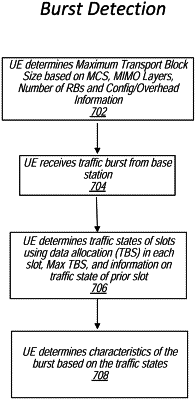| CPC H04W 28/0284 (2013.01) [H04W 24/08 (2013.01); H04W 36/14 (2013.01); H04W 36/22 (2013.01)] | 20 Claims |

|
1. A user equipment (UE), comprising:
at least one antenna;
a radio operably coupled to the at least one antenna for communicating with a cellular network;
a memory coupled to the radio; and
a processor operably coupled to the memory and the radio;
wherein the UE is configured to:
receive network traffic from the cellular network during a series of transmission slots;
identify states of respective ones of the transmission slots based at least in part on a transport block size of each of the respective slots;
determine characteristics of a burst of network traffic in the received network traffic based on the identified states of the transmission slots; and
determine that the cellular network is experiencing a bottleneck based at least in part on the characteristics of the burst of network traffic.
|